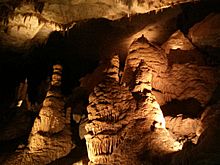Cumberland Caverns facts for kids
Quick facts for kids Cumberland Caverns |
|
|---|---|
| Higgenbotham Cave, Henshaw Cave | |

Cumberland Caverns - Three Chessmen
|
|
| Location | McMinnville, Tennessee |
| Length | 32 miles (51 km) |
| Discovery | 1810 by Aaron Higgenbotham |
| Geology | Monteagle Limestone |
| Entrances | 3 |
| List of entrances |
Higgenbotham Cave, Henshaw Cave, Onyx Curtain |
| Access | restricted |
| Show cave opened | 1956 |
| Lighting | electric |
Cumberland Caverns is a huge cave system near McMinnville. It is recognized as a National Natural Landmark, which means it's a very special natural place. This cave is the second longest in Tennessee. It is also one of the longest caves in the United States and even in the world!
Contents
History of Cumberland Caverns
The main entrance to the cave was found in 1810 by a man named Aaron Higgenbotham. He was exploring the land near Cardwell Mountain. People say he was the first person to go inside the cave. Because of this, it was first called Higgenbotham Cave.
Around the same time, another smaller cave was found nearby. It was called Henshaw Cave. Even though it was smaller, Henshaw Cave was important. It was a source of saltpeter, which is a key ingredient for making gunpowder. People used it as a saltpeter mine during the War of 1812 and the Civil War.
Early Explorers and Discovery
During the 1800s, Higgenbotham Cave became a popular spot for local adventurers. Groups would travel to the cave entrance in hay wagons. They would then make a tough trip to a large area inside the cave. This area is now known as the Ten Acre Room. Back then, it was called the Big Room. Many visitors wrote their names and dates on the ceiling using candle smoke.
In the early 1940s, a group called the National Speleological Society (NSS) started exploring Higgenbotham Cave. They are people who study and explore caves. In just ten years, they found many more parts of the cave. In 1953, they discovered that Henshaw Cave and Higgenbotham Cave were connected! This connection was very small and was named the Meatgrinder.
Soon after, some of these explorers rented the cave from its owner, Mr. Andy Powell. They decided to turn it into a show cave, which is a cave open for public tours. The cave opened to visitors on July 4, 1956, and has been open ever since.
A part of the historic Trail of Tears also goes through the land around Cumberland Caverns. There is a walking trail open to the public to see this historic path.
Visiting Cumberland Caverns
Cumberland Caverns offers many ways for people to explore the cave all year round. They say it's the biggest show cave in Tennessee. You can take a walking tour during the day. For more adventure, you can go on special cave exploring tours, called spelunking tours. You can even stay overnight in the cave! The caverns also host educational field trips for schools.
Besides tours, the cave is a unique place for events. People can have weddings, banquets, and birthday parties inside the caverns. Before you enter the cave, there is a gift shop. Here, you can buy tickets, souvenirs, and other fun items.
Cumberland Caverns Live Events
The Volcano Room inside Cumberland Caverns is a special place for music. It used to host a monthly music event called Bluegrass Underground. This event became a popular TV show on PBS that people across the country could watch.
Now, the Volcano Room is home to Cumberland Caverns Live. It hosts many different concerts and live music shows. Famous bands and artists like Sister Hazel, Kip Moore, and Deer Tick (band) have performed there.
Geology of the Cave
Cumberland Caverns formed in a type of rock called Monteagle Limestone. This rock formed during the Mississippian Period, which was millions of years ago. The cave is located on the western edge of the Cumberland Plateau, which is a large, flat area of land with steep sides.
The cave is full of amazing natural formations. These include:
- Stalagmites: Rock formations that grow up from the cave floor.
- Stalactites: Rock formations that hang down from the cave ceiling.
- Helictites: Twisted, worm-like formations that seem to defy gravity.
- Flowstone: Smooth sheets of rock formed by flowing water.
- Cave pearls: Small, round, polished stones found in cave pools.
- Botryoidal coral: Bubbly, grape-like formations.
- Gypsum flowers: Delicate, crystal formations that look like flowers.
- Gypsum needles: Thin, needle-like crystals.
- Pure white gypsum snow: Soft, powdery gypsum deposits.
The cave is also home to many different kinds of cave life.
Interesting Formations Inside
Cumberland Caverns has many unique and interesting formations:
- The Volcano Room: This is where many of the cave's public events and concerts take place.
- Monument Pillar: A very large formation made of flowstone.
- Crystal Palace: A beautiful area filled with crystals and gypsum flowers.
- The Devil's Backbone: Three tunnels for cave exploring. They are called this because their paths are winding and look like a spine.
- The Lemon Squeezer: A very narrow passageway. At its widest point, it is only 11 inches (280 mm) across!
- Bubblegum Alley: Another narrow passage, similar to the Lemon Squeezer. The ground here is often damp, making it feel sticky.
- The Hall of the Mountain King: This is one of the largest cave rooms in eastern North America. It is about 600 ft (180 m) long, 150 ft (46 m) wide, and 140 ft (43 m) tall!
Images for kids


